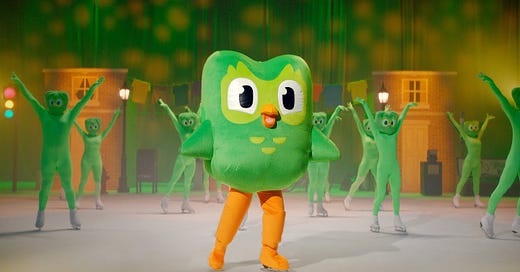The last 10-20 years have perhaps been the most influential when it comes to marketing. The advent of the internet and all its subfields (social media, online video, blogs) has completely changed both the products and services sold, and the methods of making these sales. In today’s increasingly digital and globalized world, there are numerous ways to promote products and services, with varying degrees of success. There have been some utter disasters of publicity that we have covered here before in The Bhatt Report. Today, however, I want to highlight one company that has revolutionized online marketing in the post-COVID era: Duolingo.
Duolingo’s co-founder and first CEO, Luis Von Ahn, was already well-known as a crowdsourcing pioneer and a founder of ReCAPTCHA before founding the famous owl-themed company. He found a gap for a quick and easy language-learning App and thus created Duolingo.
Much can be said about Duolingo’s business model, but to simplify, it is more of a repeat-a-day social media than a traditional language software such as Rosetta Stone. As a result, maintaining users who consistently use the app is key to Duolingo’s success. Their marketing team is so aggressive for this purpose, and this is also where the app found its greatest marketing strength.
It is frequently said that attention is a currency on social media. While this principle is popular, it is also demonstrably false. Negative publicity can and has caused significant harm to several brands (just re-read my Watcher article if you have any doubts). At the same time, positive publicity does not necessarily mean being righteous but engaging within the same ideological sphere as your customers. Duolingo has a young customer base. Hence, their social media performance had to be designed to impress Millennials and Generation Z.
Thus, Duolingo built the basic steps for its brand identity, one that would soon master. They needed a brand identifier that could tie together all the disparate threads of their brand identity. Their marketing team found that with their instantly recognizable mascot owl, Duo. Compared to nearly every other brand mascot of the last ten years, Duo has a key, recognizable design and a personality that stands out (we will get into that later).
Rather than go in sequential order, I thought I would highlight some of its biggest PR moves to illuminate its strategy. Almost all of these involve Duo being cranky and aggressive in a humorous way to advertise Duolingo.
The App Logo: Duolingo has long sought to aggressively remind users to maintain their existing streaks. As a result, if you don’t continue your streak for several days, the app logo slowly morphs into a bizarre, unhealthy-looking version of Duo. While this change initially got an adverse reaction from app users, it certainly worked to keep users on the App and actually fit very well with Duo’s brand image as somewhat mischievous and aggressive, especially since the language sentences it is known for asking are also similar,
As a result of these aggressive marketing tactics, memes were made about Duolingo’s practices. One of the most infamous ones was that Duolingo would ask you to learn “Spanish or vanish.” Most companies would react by attempting to censor this publicity, viewing it as negative to their brand. Instead, Duolingo made a musical with a song titled “Spanish or Vanish.” The English lyrics are relatively tame, pushing the listener to keep up their streak. But the Spanish lines have Duo threatening to murder and cannibalize the listener, encouraging them to learn Spanish just to fully fulfill the meme.
After the Brat trend peaked, Duolingo arranged for many of its social media staff to attend Charli XCX’s Brat tour dressed as Duo. This went viral instantly and tied Duolingo to Charli’s hit song “Talk Talk,” something that even Charli acknowledged.
On a micro level, these social media stunts might seem random, just another example of shock marketing. But from a macro perspective, with an understanding of Duolingo’s target audience of young people, a clear strategy emerges. Duolingo isn’t just taking every trend that rises and making memes out of them but aiming to make it clear that this brand is for young people, by young people.
This is accomplished not through trend chasing. Instead, Duolingo highlights ideas that mesh well with its branding. Each of their meme choices are fresh and eager for expansion, and all are handled with an 'I don’t give a damn' attitude and tons of style. Most notably, none of Duolingo’s promotions felt pushed by a marketing team from the top. Duolingo’s marketing team clearly understood the references and ideas they were poking fun of, even when they were attacking Duolingo itself.
The real reason for this is that Duolingo is keen to strengthen the talent behind its brand and marketing team. Duolingo’s marketing team is young, passionate, and very interested in the products they are selling and the style of the sale. Unsurprisingly, they excel, given that their hold on pop culture is stronger than almost any other media team globally.
If one is curious about the mindset that drives Duolingo’s social media marketing strategies, I highly recommend their global social media manager, Zaria Parvez’s newsletter, Make It Go Viral. It was an inspiration for me to start The Bhatt Report and is, in my opinion, crucial to anyone seeking to learn marketing and advertising. It covers topics such as creativity, authenticity, and much more.
Normally, I wrap things up with big business takeaways. But this time, the whole article has been one giant lesson. To sum it up: be passionate about what you do, know your audience, stay flexible with trends, and most importantly—don't be afraid to laugh at yourself along the way!




